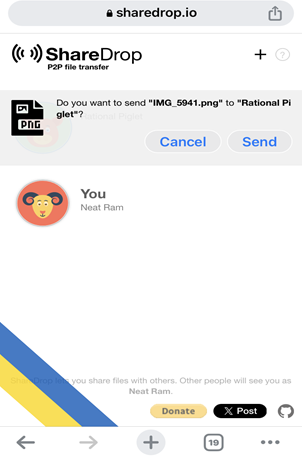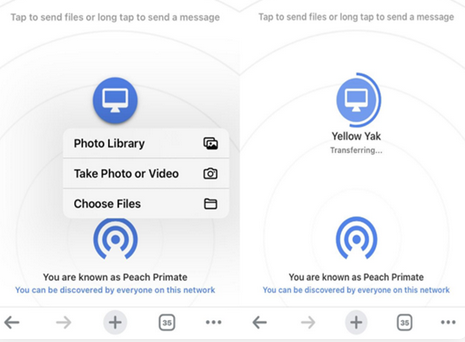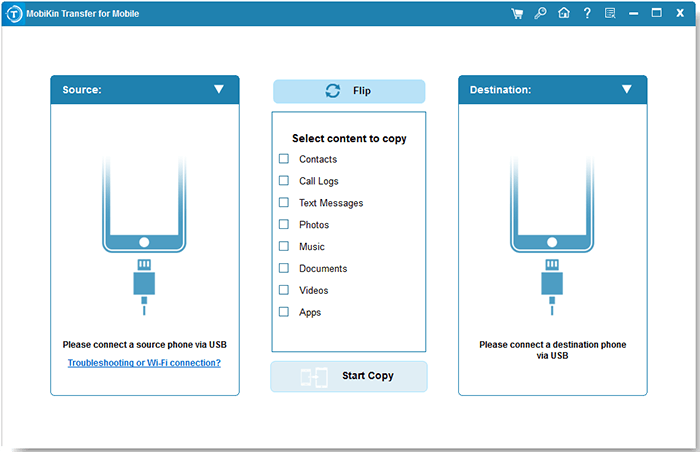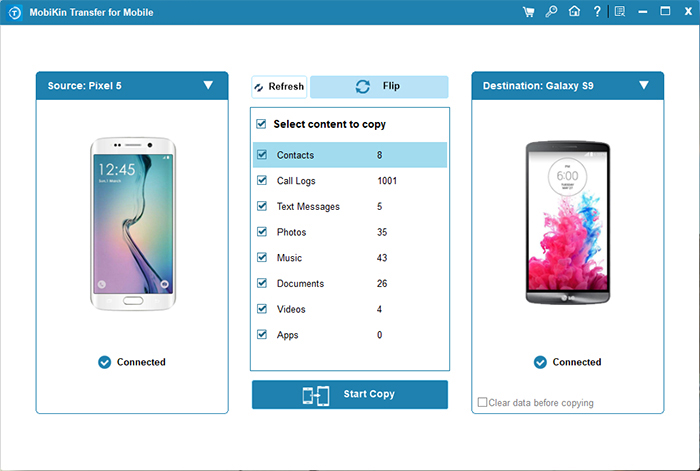ShareDrop vs. Snapdrop: Detailed Reviews/Comparison [Must-read]
When it comes to quick and wireless file sharing, many users turn to web-based tools like ShareDrop and Snapdrop. However, with both offering similar features, it's common to wonder which tool is more reliable, faster, or easier to use. Others may be checking if either tool works better on specific platforms like Android, iOS, Windows, or macOS before deciding.
This article presents a comprehensive comparison between ShareDrop vs Snapdrop, examining their core features, performance, compatibility, and limitations. Whether you're transferring files across a local network or sharing data between distant devices, this guide will help you choose the best tool.

Part 1: ShareDrop vs Snapdrop: Brief Overview
ShareDrop:
This is a free, open-source web application that allows you to easily share files between devices on the same local network (LAN) or even remotely using peer-to-peer (P2P) technology. This tool works similarly to Apple's AirDrop but is designed to be cross-platform, meaning it can be used on Windows, macOS, Linux, Android, and iOS devices. It is a replacement for Snapdrop, to some extent.
Key Features:
- No uploads – Files transfer directly (P2P).
- Encrypted – Secure WebRTC transfers.
- No installs – Works in Chrome, Firefox, Edge, etc.
- LAN & remote sharing – Best on the same Wi-Fi, but works online via a link.
Snapdrop:
Snapdrop is a free, open-source, browser-based file-sharing tool that works similarly to Apple's AirDrop but is cross-platform (Windows, macOS, Linux, Android, iOS). It uses peer-to-peer (P2P) transfer over local networks (LAN) or the internet, with no file size limits and no third-party servers.
Key Features:
- P2P transfers (no cloud uploads).
- Encrypted (WebRTC).
- No installs - works in any browser.
- Same network or remote (via link).
Part 2: ShareDrop vs Snapdrop: Similarity & Differences
|
Main Aspects
|
ShareDrop
|
Snapdrop
|
|
Network Type
|
Local & Cross-network (via link) |
Local network only |
|
File Transfer
|
Peer-to-peer (WebRTC) |
Peer-to-peer (WebRTC + WebSocket) |
|
Room Links
|
Supported (for remote sharing) |
Not supported |
|
Ease of Use
|
Very easy; extra step for remote users |
Extremely simple |
|
Privacy
|
Encrypted, direct transfers |
Encrypted, direct transfers |
|
Open-source
|
Yes |
Yes |
|
Platform Support
|
Cross-platform (all major OS & browsers) |
Cross-platform (all major OS & browsers) |
Part 3: ShareDrop vs Snapdrop: How to Use Them
How to use ShareDrop?
- Ensure that both devices are connected to the same WiFi network.
- Access ShareDrop.io on both of your devices.
- ShareDrop will identify both systems on the same network and assign distinct names that will be visible on each device.
- Confirm the names displayed on both devices to ensure they correspond.
- In this instance, the PC is labeled 'Rational Piglet' and the smartphone 'Neat Ram.'
- It is important to note that the names are generated randomly and may differ from the example provided here.
- Select the icon on the device from which you wish to send.
- Click on the location of your file or data, select the file or image you wish to send, and then tap Add.
- A pop-up will prompt you to confirm your transfer. Tap Send to proceed or Cancel to terminate the process if you choose not to continue.
- Once you tap Send, be sure to check your receiving device as well.
- Tap Save to accept the transfer.

How to use Snapdrop?
- Begin by launching Snapdrop on both of your devices: the sender and the receiver.
- Ensure that both devices are connected to the same WiFi network.
- Once the application is open, the two devices will be recognized immediately.
- Next, select the Snapdrop icon on the device from which you wish to send data.
- After that, choose the file or image you intend to send.
- Upon doing so, a notification will appear on the receiving device, prompting you to either save or disregard the file.
- Select Save, and the file will be stored on your receiving device.
- Navigate to your download folder on your PC, where you will locate the file you have just transferred.

Part 4: ShareDrop vs Snapdrop: Which One to Pick
Both are free, private, and work without accounts! Both are AirDrop-like, browser-based P2P file-sharing tools, but here's how they differ: Snapdrop wins for most users due to better performance and updates. But ShareDrop is great if you need self-hosting or open-source transparency.
Choose ShareDrop If:
- You want an open-source alternative – ShareDrop is fully open-source (GitHub).
- You prefer a simpler UI - More minimalistic than Snapdrop.
- You need a self-hosted option - Can be deployed on your own server.
Choose Snapdrop If:
- You want better reliability & updates - More actively maintained.
- You prefer a polished UI - Smoother animations and cleaner design.
- You need faster transfers - Optimized WebRTC performance.
Part 5: Best Alternative to ShareDrop & Snapdrop
While ShareDrop and Snapdrop work on mobile, many users report crashes or issues with large file transfers. For a smoother, more reliable experience, consider a specialized tool like MobiKin Transfer for Mobile (Windows and Mac). If you're looking for a trusted solution with low error rates and lossless transfers, MobiKin stands out. With years of experience, it supports one-click transfers of contacts, media, and more - efficiently and effortlessly.
Main Features of MobiKin Transfer for Mobile:
- The most efficient substitute for ShareDrop/Snapdrop when it comes to transferring data across identical or diverse platforms.
- Transfer files between iPhone and iPhone, Android and Android, Android and iPhone, as well as iPhone and Android.
- Support contacts, text messages, call logs, music, photos, videos, documents, applications, and additional formats.
- Compatible with more than 8,000 mobile devices (Support Android 16 and iOS 26)
- Offers security, ease of use, and preserves the original file size.
How to adhere to the steps below to learn how to transfer data from one smartphone to another with this software:
Step 1: Download & Installation - To begin, open the MobiKin Transfer for Mobile application on your computer after confirming that it has been successfully downloaded and installed. The main interface of the program will look similar to the image shown.

Step 2: Device Recognition - Connect your computer to both devices using USB cables. Next, allow the software to recognize both devices by following the on-screen instructions. If you have mistakenly switched the source and destination devices, simply click "Flip" to adjust their positions.

Step 3: Data Transmission - After establishing the virtual connection, choose the specific types of data you wish to transfer and click the "Start Copy" button. This action will promptly commence the data transfer from the sender to the receiver.
Video Tutorial:
In a Nutshell
While both ShareDrop and Snapdrop are convenient for basic, browser-based transfers, they still face issues like crashes, large file transfer failures, and limited cross-platform optimization. If you're looking for a more professional, stable, and fully-featured solution, MobiKin Transfer for Mobile is the clear winner.
Unlike ShareDrop or Snapdrop, MobiKin supports direct phone-to-phone transfers, handles large files with ease, works across all major platforms, and ensures lossless, error-free migration of contacts, messages, media, and more.
Related Articles:
Top 7 PC to Mobile File Transfer Apps for Windows/Mac [Detailed Guide]
Quick Share vs Nearby Share: Which Is Superior? [Overall Comparison]
App Share via Bluetooth: 5 Ways to Transfer Apps from Android to Android by Bluetooth
The Latest 11 Best Android Data Recovery Software/Tools [Free & Paid]



